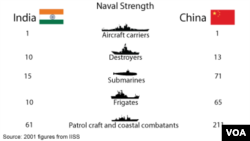China and India are rapidly expanding their naval forces, increasing the possibility of future confrontation as Asia's two leading emerging economies seek to project their power.
India's navy chief, Admiral D.K. Joshi, this week called the modernization of China's naval forces "truly impressive" and a source of "major concern," pledging to protect Indian interests in the South China Sea.
China's rising power in the region is raising concerns in New Delhi that Beijing will try to dominate the Indian Ocean with a series of planned naval ports encircling India.
The official 2011 defense budget for China was $95.6 billion, compared to India's $31.9 billion. But China analysts say Beijing's actual military spending for 2011 was at least $120 billion.
China announced an 11.2 percent increase in defense spending earlier this year, part of a decade-long expansion that has allowed China's ground, naval and air forces to embark on a sweeping modernization program. India's naval advances, while less extensive, date back over a longer period.
"The Chinese navy has been expanding very rapidly in the last decade - far more so than the Indian navy. China's [maritime forces are] more modern, but India's navy is more experienced," said Kym Bergmann, editor of Asia-Pacific Defence Reporter.
"At the moment, they are fairly evenly matched. But China is investing so much in naval capability that in another 4 to 5 years, they may have a substantial edge," Bergmann said.
Although China and India are not traditional sea powers, both countries have expanded their global ambitions, fueling the development of their navies.
China leads India in several key naval categories and by 2020 it is expected to have 73 large warships. Last year, it acquired its first aircraft carrier. India aims to have three carrier groups operating by that date, part of a larger fleet that would put it among the world's five biggest navies, according to The Economist magazine.
Australian National University defense analyst John Blaxland predicts that regional tensions will continue to rise in the South China Sea and that Beijing will not likely back down.
"The oil and gas resources that are understood to be underneath the South China Sea are potentially massive. And for a resource-starved country like China, they are too important for these little countries in Southeast Asia take from them," Blaxland said.
India's navy chief, Admiral D.K. Joshi, this week called the modernization of China's naval forces "truly impressive" and a source of "major concern," pledging to protect Indian interests in the South China Sea.
China's rising power in the region is raising concerns in New Delhi that Beijing will try to dominate the Indian Ocean with a series of planned naval ports encircling India.
The official 2011 defense budget for China was $95.6 billion, compared to India's $31.9 billion. But China analysts say Beijing's actual military spending for 2011 was at least $120 billion.
China announced an 11.2 percent increase in defense spending earlier this year, part of a decade-long expansion that has allowed China's ground, naval and air forces to embark on a sweeping modernization program. India's naval advances, while less extensive, date back over a longer period.
"The Chinese navy has been expanding very rapidly in the last decade - far more so than the Indian navy. China's [maritime forces are] more modern, but India's navy is more experienced," said Kym Bergmann, editor of Asia-Pacific Defence Reporter.
"At the moment, they are fairly evenly matched. But China is investing so much in naval capability that in another 4 to 5 years, they may have a substantial edge," Bergmann said.
Although China and India are not traditional sea powers, both countries have expanded their global ambitions, fueling the development of their navies.
China leads India in several key naval categories and by 2020 it is expected to have 73 large warships. Last year, it acquired its first aircraft carrier. India aims to have three carrier groups operating by that date, part of a larger fleet that would put it among the world's five biggest navies, according to The Economist magazine.
Australian National University defense analyst John Blaxland predicts that regional tensions will continue to rise in the South China Sea and that Beijing will not likely back down.
"The oil and gas resources that are understood to be underneath the South China Sea are potentially massive. And for a resource-starved country like China, they are too important for these little countries in Southeast Asia take from them," Blaxland said.







